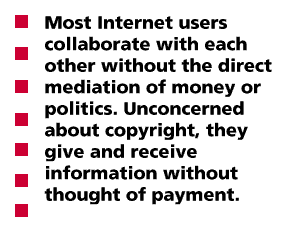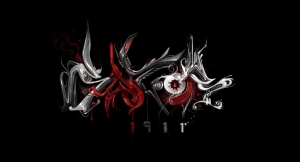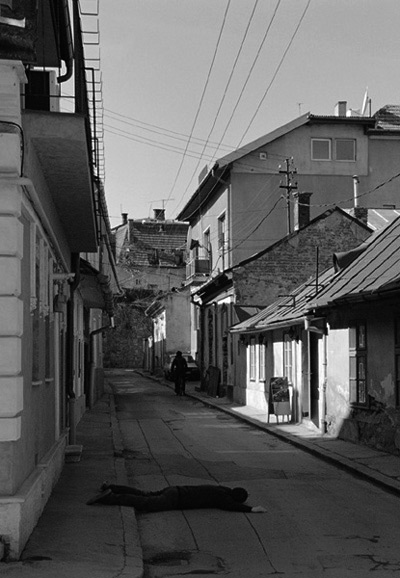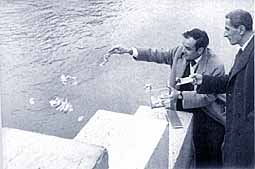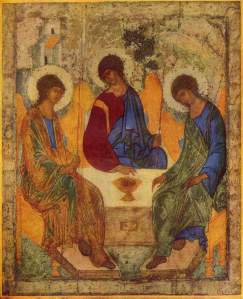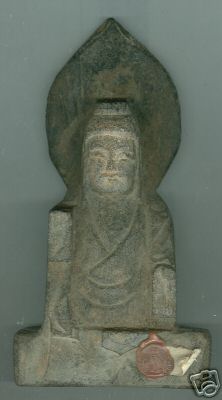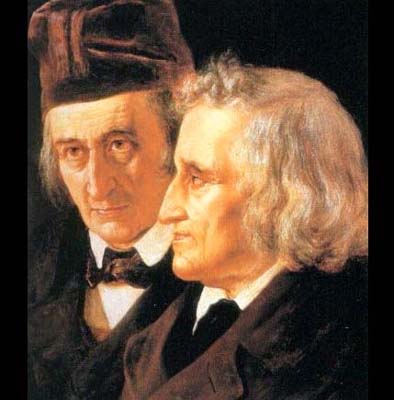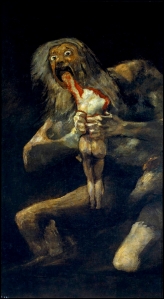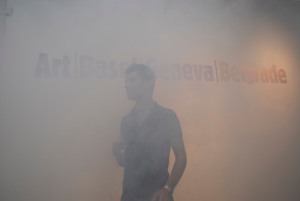Filed under: Art as Gift Research blog | Tags: artwork, gift economy, knowledge
Free Culture Game offers a ludic metaphor for the battle between copyright encroachments and the free exchange of knowledge, ideas and art. A circular field represents The Common, where knowledge can be freely shared and created; your job is to maintain a healthy ecology of yellow idea-bubbles bouncing from person to person before they can be sucked into the dark outer ring representing the forces of The Market. (via Rhizome.org)
Molleindustria, the radical game developer group did a “playable theory” work, which like many of their other games, may be played for an infinite, (update:actually this might be won, yet I never could). This near infinity of the “theory” has its purpose, as the battle for free knowledge and the market has a long history, and will have a future indeed, I am sure. The “theory” is quite straightforward, and one might say, and rather pessimistic, as there is no escape from the diabolical circle of market-free economy of knowledge. Anyway, can’t say it better, then this software application does.
If you have not met with the groups works, check out their website for their art pieces like the McDonalds Videogame.
Yesterday I had the chance to see the action hero flick Iron Man (2008), in which Tony Stark (Robert Downey Jr.), the young prodigal son, who owns an entire weapon manufacture company, faces the dire consequences of his ignorance on who and why for is using his merchandise of death, and decides to undo all evil by himself. He dresses in a super-armor and making the world a better place by eliminating the bad guys personally. Yet, in the beginning of the movie, Stark is portrayed as a flamboyant playboy and inventor with a wide selection of interest, who when asked if he resembles Leonardo Da Vinci, states that he is not painting, but “basically, yes“.
At the very moment Tony Stark realizes how awful the world is, and how much pain he caused with his business conduct, and even trough he got injured in his first mission to save earth, he summons his charming secretary and right hand Virginia ‘Pepper’ Potts (Gwyneth Paltrow) and express his will to continue on to make the world a better place as a superhero:
Virginia ‘Pepper’ Potts: Tony, you know that I would help you with anything, but I cannot help you if you’re going to start all this again.
Tony Stark: There is nothing except this. There’s no art opening, no charity, nothing to sign. There’s the next mission, and nothing else.
Virginia ‘Pepper’ Potts: Is that so? Well, then I quit.
Tony Stark: You stood by my side all these years while I reaped the benefits of destruction. Now that I’m trying to protect the people I’ve put in harm’s way, you’re going to walk out?
Virginia ‘Pepper’ Potts: You’re going to kill yourself, Tony. I’m not going to be a part of it.
Tony Stark: I shouldn’t be alive… unless it was for a reason. I’m not crazy, Pepper. I just finally know what I have to do. And I know in my heart that it’s right.
Filed under: Art as Gift Research blog | Tags: Projects critical to Artworld
« ART FOR BUSINESS’ SAKE – Technologies To The People® is a work in progress. It’s a metaphor about the use of technologies, while acting as a public provocation. I am creating a virtual company that exists only as an artistic project, though it actually operates for the rest of society. Technologies To The People® works with the media infrastructure of corporate companies. Technologies To The People® habitually sponsors artistic events through its representation policies. Technologies To The People® is aimed at people in the so-called Third World, as well as the homeless, orphaned, expatriated or unemployed, fringe groups, runaways, immigrants, alcoholics, drug addicts, people suffering from mental dysfunctions and all other categories of “undesirables”, all those without social ties and unable to find a safe place to live, all those who have to beg in order to survive. .» – Daniel Garcia Andujar, TTTP (Technologies To The People®)
”L’art pour l’art” or “Art for Art’s Sake” (Ars Gratia Artis) was the slogan for several generation of artist on the late 19th, early 20th century – as Wikipeia suggests:
“Art for art’s sake” was a bohemian creed in the nineteenth century, a slogan raised in defiance of those who — from John Ruskin to the much later Communist advocates of socialist realism — thought that the value of art was to serve some moral or didactic purpose. “Art for art’s sake” affirmed that art was valuable as art, that artistic pursuits were their own justification and that art did not need moral justification — and indeed, was allowed to be morally subversive.”
For those who are familiar with the nowadays relation of art and business funding, the above quote may sound a little bit odd as the artistic struggle for identity and self affirmation, in which “L’art pour l’art” was an important step to make, seems to diverted to a different direction, towards the Art for Business’ Sake…
Currently I am digging myself into Raoul Vaneigem’s The Revolution of Everyday Life, an important work on the possibility of total self management and gift-economy. In the same time I also found some articles, like The High-Tech Gift Economy by Richard Barbrook, or Internet Gift Economies by Kylie Veale and in the same time, also browsing trough the Subsol index, which is a large collection of really interesting readings on art and economy related subjects, including: Self-Organizing Markets by Manuel de Landa, New Media Culture in the Age of the New Economy by Geert Lovink, and Some Thoughts on the Idea of “Hacker Culture” by Patrice Riemens.
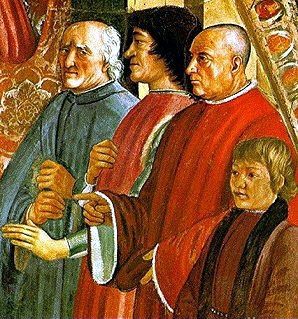
The donor Francesco Sassetti with his son on the main mural of the Sassetti Chapel, Florance by Domenico Ghirlandaio
The “gift” is an item or action which is offered with not asking compensation in return.
An “artwork” is an artificial object – as the objects created by the nature are can not considered to to be artworks, according to Hegel, unless they implement an element of mind (human), which in fact means that human intervention is needed, at least on a conceptual level to annotate these items as artworks:
(…) For it is possible even for finite nature, in its particular scenes and phenomena, to make its appearance in the realm of art, if only some allusion to an element of mind endows it with affinity to thought and feeling. (Hegel’s Lectures on Aesthetics, Part III, from Marxist.org )
Therefore “artwork gifts” are highly precious objects which needs a high level of human artifice skill to produce (skill and talent) and are donated as gifts. I am writing about discrete artworks now, and excluding the notion of artworks which deliberately made for a purpose, for example advertisements of any kind.
Let’s see three different kind of donations on the framework of art(works) and donating.
- Donating art as a personal gift: Like any other commodity, the work of a craftsman is transferred from one owner to another. Either be the creator (artist) to the receiver, or by a third party to the receiver with adequate compensation to the craftsman. An ornate wedding ring, or a portrait might be a good example. Please consider that these objects has a purpose, they remind the receiver to whom they got the “gift” from.
- Donating art to the public: The same exchange as above, but without a single receiver as such, for example a legal body (state) decides to commission a craftsman to decorate a public area. The commissioner ask nothing in return from the receiver, and in most cases the creator of the artwork is compensated. Any 19th century public monument of public space (public gardens, parks etc.) might do.
- Donating art as a form of representation: It is possible to do the above (ie: donating to the public as a gift), but in the same time involve a form of exchange. The commissioner-giver, gets something in return what is special to a highly detailed and precious object can offer: attention. As an artwork is a discrete object, a singular work of craftsmanship which holds an unique message, as it is a focus of all attention in the art world. For example a significant mural, which holds a large degree of craftsmanship and innovative power, commissioned by a wealthy giver, who can afford to do so. In this case the gift receives a new layer of understanding: it is free, but helps the personal interest of those who made it possible to exist.
What makes this third kind of exchange really interesting is its uniqueness to art. Why would anyone create or commision any object without compensation and make it public? Unless he/she is not obliged to represent him/herself in any other way. And here becomes the question really interesting:
We are the result of your laws.
We are the result of your democracy.
We are the result of your corruption. (PROCYON group announcement)
One of the most important aspect of hacker culture is the donation of the stolen (hacked) product to the public, turning the result of the heist into a free, shared public commodity. In theory, the activity of the hacker aims to free up the intellectual products which are held back from the public by its ruthless, profit seeking publishers. The hacker mythology was always very aware to the general rules of gift economy, and as it become widespread with the generational change of the last few years, the generation, of which elite are mostly made up of ex-hackers are supporting many different kind of alternative economy models. After all, they have realized, that if they publish (others) intellectual properties for the public, they have to rely on similar exchanges in many other filed of economy.
But let’s take a quick overview on the notion of gifting in this culture: and especially the aspect of warez , the distribution of stolen, (pirated) movies and software applications.
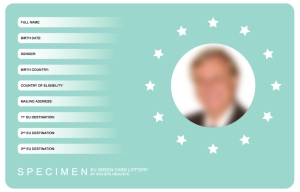
An EU Green Card, won on the EU GREEN CARD LOTTERY, made by the artist group Societe Realiste (http://www.green-card-lottery-eu.org/)
Lottery, the last flicker of hope to the needy or the guiding light for those who are waiting to get a Green Card to the United States, divides our society. Some consider it to be an ultimate evil:
Lotteries are most often run by governments or local states and are sometimes described as a regressive tax, since those most likely to buy tickets will typically be the less affluent members of a society. The astronomically high odds against winning the larger prizes have also led to the epithets of a “tax on stupidity”, “math tax” or “voluntary tax”. They are intended to suggest that lotteries, being an addictive form of gambling, are governmental revenue-raising mechanisms that will attract only those consumers who fail to see that the game is a very bad deal. Indeed, the desire of lottery operators to guarantee themselves a profit requires that an average lottery ticket be worth substantially less than what it costs to buy. (via Wikipedia)
But for some, lottery is a form of donation: the first ticket were some form os shares, which were used as a loan to raise money to different issues, like founding colonies in the 17-18. century, or to build cultural institutions:
Lotteries in colonial America played a significant part in the financing of both private and public ventures. It has been recorded that more than two hundred lotteries were sanctioned between 1744 and 1776 where they played a major role in financing projects that included roads, libraries, churches, colleges, canals, bridges, etc.[3] In the 1740s, Princeton and Columbia University had their beginnings financed by lotteries, as did the University of Pennsylvania by the Academy Lottery in 1755.
In England, the National Lottery for Good Causes is financing a wide range of cultural, social, environmental projects – as the name suggest, they do good anywhere in the world.
It was a widespread custom in the 18-19. century to raise funds with lottery, yet, these event were held for an exclusive audience, who did a compulsory donation, and won some sort of minor present in return. Yet, very little research was done on this issue. If I can manage to grab a book on the issue, I will post it here later.
Filed under: Art as Gift Research blog | Tags: Projects critical to Artworld
Even trough there are many artist who archived much in the process of dematerialize contemporary art works, a few matches Yves Klein, who, with an ultimate gesture, wasted a small quantity of gold into the river Seine.
“Moreover, Klein sought a way to evaluate his ‘immaterial pictorial sensitivity’ and decided that pure gold would be a fair exchange. He offered to sell it to any person willing to purchase such an extraordinary, if intangible, commodity, in exchange for gold leaf. Several ‘sales ceremonies’ were conducted: one took place on the banks of the River Seine on 10 February 1962. Gold leaf and a receipt changed hands between the artist and the purchaser. But since ‘immaterial sensitivity’ could be nothing but a spiritual quality, Klein insisted that all remains of the transaction be destroyed: he threw the gold leaf into the river and requested that the purchaser burn the receipt. There were seven purchasers in all.” (via Webhaven gallery, From the book “Performance Art” by RoseLee Goldberg, Thames and Hudson, London, 1988)
Wikipedia tells the following about the transaction:
In the performance piece, Zones de Sensibilité Picturale Immatérielle (Zones of Immaterial Pictorial Sensibility) 1959-62, he offered empty spaces in the city in exchange for gold. He wanted his buyers to experience The Void by selling them empty space. In his view this experience could only be paid for in the purest material: gold. In exchange, he gave a certificate of ownership to the buyer. As the second part of the piece, performed on the Seine with an Art critic in attendance, if the buyer agreed to set fire to the certificate, Klein would throw half the gold into the river, in order to restore the “natural order” that he had unbalanced by selling the empty space (that was now not “empty” anymore). He used the other half of the gold to create a series of gold-leafed works, which, along with a series of pink monochromes, began to augment his blue monochromes toward the end of his life.
The custom of “friendship hospitality”, Xenia – generous treatment of strangers, wanderers, dates back to the Ancient Greek times. Zeus Xenios, Wandering Zeus was the patron gods of travelers, who could expect to find a bowl of warm soup and a bed anywhere in the Ancient Greek lands. A violation of Xenia led to the outbreak
Amazon Noir is another project by the artist/hacktivist team Ubermorgen.com, which exploiting a trivial element of the amazon.com website. You can search for any phrase in any of the books which the site offers for sale and you will get a short, 50 word quotation from the book. Ubermorgen started the process, as they searched for the first few words of any book, then used an algorithm to copy the last sentence and search for it again. Then sentence by sentence, entire books was reconstructed by the automatic algorithm in a matter of moments.
Rai Stones are a special form of currency, which acts as symbolic item in exchanges on the Micronesian island of Yap. It does resembles a large stone coin, craved out of limestone, has an average width of 1 meter and weights up to 4 tonnes.The stones value is changing according to its history, where was it transported, and if anyone died during its transport.
Rai stones were used in social transactions such as marriage, inheritance, political deals, sign of an alliance, ransom of the battle dead or just in exchange for food. Many of them are placed in front of meetinghouses or specific pathways. Though the ownership of a particular stone changes, the stone itself is rarely moved. The names of previous owners are passed down to the new one. (via Wikiepdia)
Further information on the rai stones, and their useage on the wikipedia. I would higlight the fact that the colonial Japanese forces used them as anchors as they found no value in these items.
(image is by Rudy)
Ebay a day is an attempt to redefine the distribution of the artworks in the current market economy situation of the contemporary Artworld. Using the distribution channels of an already well known system of barter, the online auction house Ebay in the form of an online, temporal exhibition.
Curated by Rebekah Modrak, Aaron Ahuvia and Zackery Denfeld, ebayaday consists of 25 auctions (one debuts each day) in which the entire eBay listing (item for sale, descriptive text and imagery and placement within chosen categories) is the artwork. Works presented in the show exploit, redefine or underscore eBay’s potential in the exchange of ideas, objects and money.
Ebayaday is a month-long, curated exhibition on eBay designed to exploit, redefine or underscore eBay’s potential as a site for the exchange of ideas, objects and commerce. Each of the 24 artists juried into the show received instructions for one specific day and time to post a listing in a 7-day online auction on eBay.com. Unlike the thousands of traditional art objects for sale on eBay at any given moment, the pieces in ebayaday incorporate the various methods and systems of eBay as elements in the work. Each aspect of the listing (item for sale, descriptive text and placement within chosen categories) is a part of the artwork. (from the ebayaday.com website)
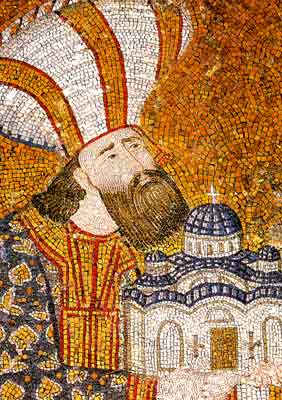
Mosaic of enthroned Christ with Theodore Metochites presenting a model of Chora Church, Istanbul (detail)
The Museum of Modern Art opened with six rooms on the twelfth floor of an office building on the corner of Fifth Avenue and 57th Street, New York, and changed locations more than ten times over the next ten years. One of the three founder, Abby Aldrich Rockefeller’s husband: “was opposing the idea of the museum (as well as to modern art itself) and refused to release funds for the venture, which had to be obtained from other sources and resulted in the frequent shifts of location. Nevertheless, he eventually donated the land for the current site of the museum, plus other gifts over time, and thus became in effect one of its greatest benefactors. ”
Filed under: Art as Gift Research blog | Tags: Projects critical to Artworld
RAF / Reduce Art Flights is a campaign which upholds that the art world – artists, curators, critics, gallerists, collectors, museum directors, etc. – could or should diminish its use of aeroplanes. It was initiated by the artist Gustav Metzger.
Goethe, Johann Wolfgang once decided to visit the brothers Boisserée, for closer inspection of an artwork from their collection – he traveled for two weeks to the brothers mansion, and after arrival, was escorted to a empty studio, in which only the painting which he desired to investigate was exhibited. The master carefully studied the painting and then, without a taking a glance to the rest of the paintings, traveled back to Weimar.Four weeks at least for a single image, fascinating isn’t it? What about nowadays, should Goethe, or a theoretician or critic like him would attend to all of the 140.000 contemporary art exhibition we have, and would he/she use an old, four horse driven coach ? And what about the rest of the participants of the Art world?
Stone Soup is a fable collected by the Brothers Grimm – and found in many diffrent versions all across Europe – about the benefits of cooperation and selflessness.
According to the story, some travelers come to a village, carrying nothing more than an empty pot. Upon their arrival, the villagers are unwilling to share any of their food stores with the hungry travelers. The travelers fill the pot with water, drop a large stone in it, and place it over a fire in the village square. One of the villagers becomes curious and asks what they are doing. The travelers answer that they are making “stone soup”, which tastes wonderful, although it still needs a little bit of garnish to improve the flavor, which they are missing. The villager doesn’t mind parting with just a little bit to help them out, so it gets added to the soup. Another villager walks by, inquiring about the pot, and the travelers again mention their stone soup which hasn’t reached its full potential yet. The villager hands them a little bit of seasoning to help them out. More and more villagers walk by, each adding another ingredient. Finally, a delicious and nourishing pot of soup is enjoyed by all. (via Wikipedia)
Nowadays, a large number of collaborative, non-profit project embark this very title – in some extent, the allegory of the stone soup functions as a model for a new, peer based economy, in which a large amount of “free”, or “gift” work brings a valuable final product.
“Google will eat itself” is an art/hacktivism project by Ubermorgen.com which is intended to slowly take over the search engine giant Google from inside: it is generating income with Google’s own advertisement system and then turning the profit into Google company shares, therefore buying out the very same system they are using.
Which means 371of them on each an every day.
“Artfacts.Net™ is an international online gallery and museum Guide for modern, contemporary and emerging art. ” – monitors and displays all of these events, including the artist exhibited (…)” – as stated in their introduction, right next to this fascinating number.
Periferic 8 is also included, under the biennial entries, from which they feature 371 . One would wonder how could anyone keep track of so many events, artists, facts? But let’s take a look on what is included in this magnificent database.
Artfacts.net has a special ranking system: as some kind of contemporary art Who-is-Who, it gathers the name of each and every artist who exhibits in one of the many monitored spaces what they cover, and based on some algorithm, allocates a rank in this system of all artist all around the world. The more higher ranking artist you exhibit with, the higher rank you can get – therefore a ladder of artist is created, but for whom, why and how?
Continue reading
Filed under: Art as Gift Research blog | Tags: Projects critical to Artworld
Art Basel Geneva is a dislocation or hijacking of one of the most prestigious contemporary art fair in Europe. Why would anyone fake an event like “the Olympics of the art world“? Maybe because these high masses of of the commercial Artworld, have left little ground for artistic expression, in favor of an economic contest of commodities and brand names? Click below to find out more:

Burning Man by Aaron Logan, source: http://www.lightmatter.net/gallery/albums.php
For more than two decades, on every Labor Day tens of thousands of participants gather at the temporary city of Black Rock City, Nevada, to build a huge, 12 meter high wooden effigy and finally set it on fire.
One of the basic organizing principle of the event, which attracted almost fifty thousand visitor this year (2008), is the lack of monetary transfer: gift economy. Only then the tickets to the city itself, and the basic needs like drinks, water and ice can be exchanged by using cash, any other transaction should be used by the means of gift economy.



